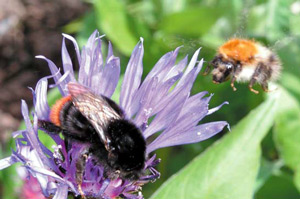Bumblebee decline has been documented across many
European countries. Bumblebees are important as pollinators of important crops, such as red clover and fruit crops, and they are also possible indicator species of change at the landscape level. Agricultural intensification, through loss of habitat, loss of plant diversity, use of pesticides, etc., is regarded as the major cause of their decline.
 A queen red-tailed bumblebee foraging on a plant in a garden while a common carder bee flies past. The red-tailed species is now less common in farmland and the carder bee is one of the two species found "everywhere". An Irish country name for the common carder is Foxy Dan!
A total of 18 bumblebee species have been recorded consistently in Ireland. As part of the Ag-Biota Project, bumblebees are being monitored on a range of typical lowland farms including tillage, dairy, beef and mixed farming. Stocking levels and fertilizer application levels are noted in each case. Line transects 200m long are established on farms through swards and along hedgerows or woodland edges. The species, caste (worker, male, queen) and flower visits of bees within 5 metres of the line transect are recorded. Each transect is visited between 2 and 4 times from June to September each year during weather favourable to bumblebee activity.
A queen red-tailed bumblebee foraging on a plant in a garden while a common carder bee flies past. The red-tailed species is now less common in farmland and the carder bee is one of the two species found "everywhere". An Irish country name for the common carder is Foxy Dan!
A total of 18 bumblebee species have been recorded consistently in Ireland. As part of the Ag-Biota Project, bumblebees are being monitored on a range of typical lowland farms including tillage, dairy, beef and mixed farming. Stocking levels and fertilizer application levels are noted in each case. Line transects 200m long are established on farms through swards and along hedgerows or woodland edges. The species, caste (worker, male, queen) and flower visits of bees within 5 metres of the line transect are recorded. Each transect is visited between 2 and 4 times from June to September each year during weather favourable to bumblebee activity.
We have some comparative data based on transects in Burren farmland during 2004 and a collection dating mainly from the 1970s. To compare data collected with unequal sampling effort, a statistical technique called "Rarefaction" is used.
If 120 bumblebees were to be observed in each habitat, then on typical farmland one would expect to see between 4 and 7 bumblebee species and on Burren farmland one would expect to see between 8 and 13 species. Hence, there are fewer species on typical farmland compared to Burren farmland. In one hour one would expect to see 72 bumblebees on Burren farmland, one would expect to see 19 bumblebees on typical farmland. In typical Irish farmland, only two species are really found "everywhere". Hence it is urgent that we identify the conditions and practices which best suit the continued presence of bumblebees on Irish farms.
Contact: Veronica Santorum or Dr John Breen,
Department of Life Sciences, University of Limerick;
E-mail:
[email protected];
[email protected];
Ag-Biota website:
http://www.ucd.ie/agbiota/index.htm
|

